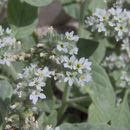en
names in breadcrumbs


Heliotropium europaeum is a species of heliotrope known by the common names European heliotrope[1] and European turn-sole.[2] It is native to Europe, Asia, and North Africa, but it is widely naturalized elsewhere, such as in Australia and North America. It grows as a roadside weed in some places. This is an annual herb growing from a taproot and reaching maximum heights near 40 centimeters. The stem and oval-shaped leaves are covered in soft hairs. The inflorescences are coiled spikes of white flowers with fuzzy or bristly sepals. Each flower is just a few millimeters wide. The fruit is a bumpy nutlet.
Heliotropium europaeum contains pyrrolizidine alkaloids and is poisonous.[3]
Heliotropium europaeum is a species of heliotrope known by the common names European heliotrope and European turn-sole. It is native to Europe, Asia, and North Africa, but it is widely naturalized elsewhere, such as in Australia and North America. It grows as a roadside weed in some places. This is an annual herb growing from a taproot and reaching maximum heights near 40 centimeters. The stem and oval-shaped leaves are covered in soft hairs. The inflorescences are coiled spikes of white flowers with fuzzy or bristly sepals. Each flower is just a few millimeters wide. The fruit is a bumpy nutlet.